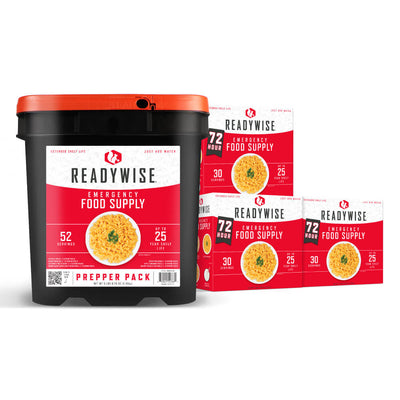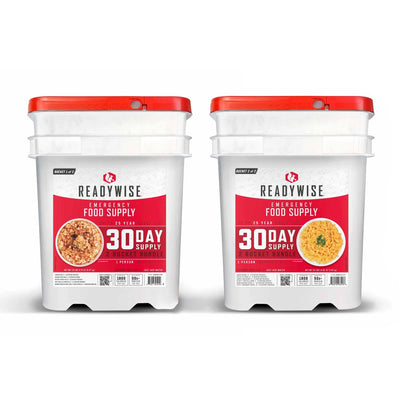From a major power outage to a natural disaster, you may find yourself in an unexpected circumstance without electricity, food, water, or shelter. While you can’t predict these situations, you can make sure you’re prepared.
Military and police agencies require their officers to carry a three-or five-day emergency go-bag with survival essentials, and you can do the same. While you may not face similar potential emergencies, you should follow their lead and pack a go-bag, also called a bug-out bag, with everything you need to survive when the unexpected happens. If you're wondering what to pack in go-bag, here’s a guide to get you started.
Start With the Bag
Since your go-bag will be your lifeline during an emergency, you don’t want to use any old backpack. Invest in a sturdy tactical bag with inner and outer compartments. The compartments allow you to organize your essential supplies and pack more in a small space. Also, make sure your bag has exterior hook and loop fixtures, allowing you to attach a knife, flashlight, or any other item you may need to access quickly without opening your pack.
Find a bag that’s at least 50 liters with the storage capacity to hold all of your essential items. Don’t forget to invest in a waterproof bag to keep the contents dry in rain or inclement weather, or if you find yourself stranded near the water.
Water
Water is the number one must-have item for your bug-out bag; you can survive about three weeks without food, but you can only last around three days without water, according to LiveScience. Pack pre-filled bottled wateror a hydration bladder. Some tactical backpacks come with a bladder, and if yours doesn’t, you can buy one yourself.
The difficult part is figuring out exactly how much water you need in your survival pack. This number will fluctuate based on factors like your weight, the amount you sweat, and caloric expenditure, in addition to the climate and temperature. While you’d ideally like to have a three-day supply, that much water can get heavy and take up space needed for other items.
Decrease the weight by packing iodine tablets, water purification tablets, or a filtration device so you can purify water from natural sources if you’re running low.
Food
You need portable, non-perishable food for your bug-out bag; the types of things you would bring camping or backpacking, like energy bars and high-protein foods like nuts and trail mix. Since you can’t predict how long you might be without food, pack high-caloric options that will give you the energy you need. MREs (Meals-Ready-to-Eat) are great options, as well as pre-made Emergency survival food, Freeze-dried emergency food, and Meal-replacement shakes. Make sure to pack granola bars and other food items that are compact, lightweight, and nutrient-dense. Also, consider packing plastic ties for sealing opened food packets or bags to preserve freshness.
Shelter
The shelter is another important basic necessity for survival but can be tricky to prepare for with minimal space in your pack. The best portable shelter options are retractable items that can fit into a bag. Lightweight tents work great for go-bags because they don’t add too much excess weight and take up minimal room.
You also need to include blankets and items for warmth. A traditional sleeping bag may not be your best option, thanks to its bulky nature. Instead, find a 50-degree compact sleeping bag that’s made for cold weather, or pack an Emergency Bivvy for added warmth and protection.
Clothes
The problem with a go-bag is that, while you’re trying to prepare for the unexpected, you never know what environment you may find yourself in. If you live in or frequent an area that favors one climate over the other, focus on packing for those temperatures. Remember, however, that even warm locales like the desert can get cold at night.
Here are some basic guidelines for must-pack clothing items for your go-bag:
- Gloves (a pair of work gloves and a pair for cold weather)
- Hats (to keep you warm or shield the sun)
- Thermals
- Socks and underwear
- Jacket
- Poncho
- Boots
- T-Shirt and Jeans or hiking/outdoor pants
Survival Items
One of the most important survival items is a multi-purpose tool. A rigid carbon-steel knife is another important piece of equipment, which can be used for chopping branches, slicing food or cutting string or wire. In the worst-case scenario, you can also use it for protection. Your best bet is a knife that fits in your hand and you can handle with ease.
Make sure to pack the following in your additional compartments:
- A first-aid kit
- Extra batteries
- Battery operated flashlight
- Headlamp
- Rope, cords, and tarp
- Compass
- Sewing Kit
- Solar AM/FM radio (optional)
- Solar charging pack (optional)
- Emergency cash (in the form of small bills)
Also, keep in mind that in an emergency evacuation situation, you’ll need to quickly grab important documents like your passport, ID, insurance papers, and any other personal documents. Keep them in a plastic bag to keep them dry. If you have pets, pack pet food for them as well. You never know when you’ll need to make a quick evacuation, and having these essentials prepared is a good idea.
While it’s impossible to prepare for every unforeseen circumstance, having a well-packed go-bag will help you get through an emergency. Whether you’re shopping for survival items in-store or online, make sure to do your homework, research products, read customer reviews, and talk to experts. It never hurts to be prepared, and packing a go-bag is a key step in expecting the unexpected.
















































































